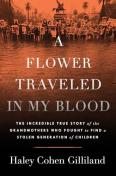
by Cohen Haley Gilliland
Hardcover- $17.63
Click on the ORANGE Amazon Button for Book Description & Pricing Info
Overall rating:
How would you rate this book?
Member ratings
A Flower Traveled In My Blood, Haley Cohen Gilliland, author; Alejandra Reynoso, narrator
At times, the book is more about the history of Argentina than about the missing victims of the Dirty War. At times it is repetitive, disjointed, and a bit woke, but at no time is it disappointing. This author presents an incredibly detailed history of Argentina’s political landscape, concentrating on the years beginning with the rule of Juan Peron until the present day, but also harkening back further in history to give a thorough overview of the development of its political leadership. She traces the progress of conservative policies as they slowly replaced left-wing policies and led to the changes that took place in the country bringing turmoil and tragedy.
By the mid 1970’s, Argentina’s government was growing chaotic. Ruler after ruler was unable to restore the country’s economy and social principles. After Peron was overthrown, for the second time, a military government gained power. With Jorge Rafaél Videla, in 1976, came a regime of terror that began for any and all who opposed him or was deemed a left-wing subversive. He was responsible for the Guerra Sucia, the “Dirty War” in which thousands of those who opposed him were kidnapped, tortured and murdered in the most violent ways. Their whereabouts were unknown and they became the desaparecidos, a growing community of the disappeared. Once taken, they were never seen again. No information was provided for the families as to their whereabouts. Thousands simply disappeared.
Many of the women suffering the monumental loss of family members sought, indefatigably, to find the missing, but to no avail. Finally, they formed a group called the Mothers of the Plaza de Mayo, (Madres de Plaza de Mayo). They staged marches and protests as they sought to bring attention to their cause, which was simply to know the whereabouts and condition of their loved ones. Soon, they realized that not only their children were missing, but so were many grandchildren that had been taken or born in captivity. These women became known as the Associacion Abuelas de Plaza de Mayo, (the grandmothers, worked tirelessly for decades to recover the children).
The barbaric tactics of the military government continued largely until the end of the regime of Reynaldo Bignone and the beginning of Raúl Alfonsin’s term in 1983. He reinstated a more democratic government and as the truth began to be exposed, although those guilty continued to hide their sadistic deeds from the public, the times began to change and justice for the grandmothers began. However, it was not without controversy, since years had passed. The grandmothers and the children’s memories were faulty and many did not want to leave their families, even if they had been obtained by ill-gotten means.
Early on, in an effort to be able to identify and positively find the children or bodies of their relatives, the grandmothers had reached out to Mary-Claire King, a scientist from California whose work on mitochondrial DNA might be able to help them definitively pinpoint their relatives. This woman, an accomplished genetic scientist, was eager to help them. Her work allowed the isolation of genes that could, with nearly 100% success, positively identify their missing children and relatives, if and when they were found. Today she is also known for her discovery and naming of the breast cancer gene, BRCA1, that proved a genetic connection in victims. Her brilliance and accomplishments are well known. She actively works on human rights investigations in many countries. It was the work of Mary-Claire King that allowed the teeth, bones and bodies of the murdered disappeared to be found and identified.
During the time of the Dirty War, those deemed to be subversive were abducted and judged to be guilty, without so much as a trial. Many Jews were the victims of the kidnappings and lootings because antisemitism was wide-spread, although the author did not really make mention of that or dwell on it in the book, except to emphasize that the organization of madres had as one of its founding members, Rosa Tarlovsky de Roisinblit, a Jewish woman whose activist efforts are actually the beginning and major focus of the book. Her daughter and son-in-law were both kidnapped and never seen again. At the time of the kidnapping, her daughter was eight months pregnant. In addition, Jacobo Timerman is briefly mentioned, and he too is a Jewish journalist who exposed the atrocities of the government and was kidnapped and tortured for more than a year. He was fortunate to be released and not thrown, alive, from airplanes to drown in the river below. He was exiled to Israel, eventually.
Because the narrator used a Spanish accent to be authentic, I did not recognize many of the names or words she used, however, after finishing the book, I did some research to identify what I was unable to understand. I think a print book is more advisable, therefore, than an audio, for someone unfamiliar with the Spanish language. The history of Argentina is fascinating, the scientific discoveries that helped uncover the “disappeared” was really interesting, the conflicts of the victims of this terrible time were intense and sometimes had tragic results. Not all the disappeared wanted to be found. Although they realized if they were indeed stolen children, given to others to raise to prevent the spread of subversion, although their own parents might have been brutally tortured and their adoptive parents might be guilty, they were still their parents and they loved them. I wonder how most readers will feel about this. Do you rip a child away from a family they have identified with after years have passed if they are unwilling? Should the child have a say in the matter? What is the child is now an adult? Is the genetic heritage the be-all end-all policy? Is it fair for the grandparents and the children to become political footballs when they are the victims not the villains? Should the parents who took the children, falsifying their adoptions, get away with their crimes? Should the military get away with theirs because they were simply following orders? So many conflicts, some perhaps unexpected, arose. The one certainty that was proven was the barbaric conduct of the government, the military and the other participants, in whatever scheme they were willingly or forced to engage. The stories are heartbreaking, and only a cold-hearted sadist could have carried out the deeds revealed in this book, especially after the world’s awakening to the horrors of The Holocaust of World War II. Yet today, we see a world that is unwilling to condemn sadism and antisemitism, once again, and is supporting those in the Middle East that carried out a heinous, barbaric act of torture and murder that still continues since there are Jewish hostages in captivity being starved to death. Will history condemn them and bring justice to the Jews of Israel someday as they brought justice to the grandmothers? Why are there no major protest marches to accomplish that goal?
Book Club HQ to over 90,000+ book clubs and ready to welcome yours.
Get free weekly updates on top club picks, book giveaways, author events and more








